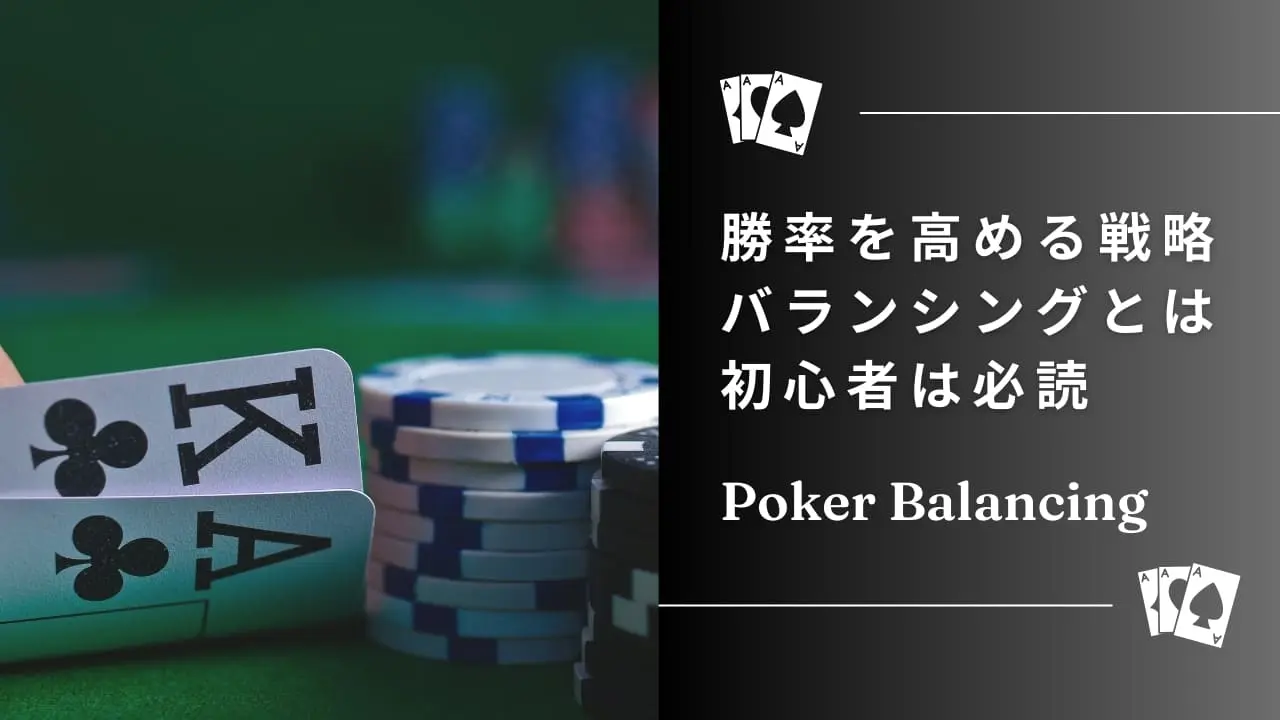To consistently win in poker, it’s not enough to only play strong hands—you must also play strategically. One of the most crucial skills for this is “balancing.”
This article will explain the fundamentals of balancing, practical applications, and easy-to-implement strategies that even beginners can use right away.
What is Balancing in Poker?
In poker, “balancing” refers to adjusting your playstyle and betting patterns to prevent opponents from easily reading your hand strength.
For example, if you only bet when you have a strong hand and always check with weak hands, your opponents will quickly catch on. By using balancing, you make similar bets regardless of whether you hold a strong or weak hand, making it difficult for opponents to get reliable information.
Example:
If you hold A♠ A♦ and bet the same way as when you have A♠ 5♠, your opponent will struggle to determine whether you’re betting with a strong hand or bluffing.
Why is Balancing Important?
Balancing your play provides several advantages:
1. Developing an Unreadable Playstyle
If your opponents can’t pinpoint your hand strength, they are more likely to make mistakes. For example, using consistent bet sizes prevents them from forming accurate reads on your actions.
Example:
On a board of J♦ X♦ 9♠, whether you hold A♠ A♣ or K♣ Q♣, using the same bet size confuses your opponent and forces them to guess your hand strength.
2. Maximizing Bluff and Value Bet Efficiency
If you bluff frequently, opponents will suspect bluffs even when you have strong hands. This makes your value bets more effective while also increasing the success rate of your bluffs.
Example:
If you regularly bluff, your opponent might think, “They’re bluffing again,” and call even when you have a strong hand, allowing you to extract more value.
3. Gaining an Edge Against Skilled Opponents
Higher-level players analyze betting patterns closely, making balancing a crucial skill when playing against them.
Example:
If an experienced opponent believes you only bet big with strong hands, they’ll fold more often, reducing your profits. By balancing, you make it harder for them to adjust, increasing your winnings.
Essential Balancing Techniques
1. Adjusting Bluff-to-Value Bet Ratio
Balancing requires maintaining an optimal ratio of bluffs and value bets. If you only value bet, opponents will fold too often, limiting your profits. Conversely, excessive bluffing results in frequent calls and losses.
Example:
When making a continuation bet (CB) on the flop, ensure about one-third of your bets are bluffs.
Flop: A♠ K♦ 7♣
- Hand: Q♠ J♠ (gutshot straight draw) → Bluff bet
- Hand: A♣ K♠ (top two pair) → Value bet
By betting similarly with strong hands and draws, you remain unpredictable.
2. Using Consistent Bet Sizes for Different Hand Strengths
Maintaining uniform bet sizes for strong hands and bluffs prevents opponents from deducing your hand strength.
Example: Flop: Q♠ 9♦ 4♣
- Holding A♠ A♣ → Bet 60% of the pot
- Holding J♠ X♠ (gutshot straight draw) → Bet 60% of the pot
Since both hands use the same bet size, your opponent won’t easily distinguish your holdings.
3. Balancing Based on Position
Balancing strategies should also vary depending on your table position.
Early Position (EP):
- Play stronger hands and reduce bluffing frequency.
- Example: Open raise with A♠ K♣ from UTG.
Late Position (LP):
- Expand your hand range and incorporate more bluffs.
- Example: Raise with 7♠ 6♠ from the button to steal the blinds.
By adjusting your approach per position, you maintain an unpredictable strategy.
Practical Applications of Balancing
1. Identifying Good Bluffing Opportunities
When your opponent appears weak, semi-bluffing can help you win the pot.
Example:
- Your Hand: A♠ 5♦ (flush draw)
- Flop: 7♠ J♦ 2♠
Since your opponent likely has a mid or low pair, an aggressive bet might force them to fold.
2. Deceptive Value Betting
Disguising strong hands as bluffs can encourage opponents to call more frequently.
Example:
- Your Hand: K♠ K♠
- Board: K♠ 7♦ 2♣ 9♠ 4♠
A small bet here might make your opponent suspect a bluff and call with a weaker hand.
Mastering Balancing: Key Tips
1. Practice and Review Hands
Improving balancing requires conscious practice and self-analysis. After each session, review your plays to identify successful balancing strategies.
Practice Methods:
- Review hand histories to check if your bet sizes were well-balanced.
- Use poker tools like GTO solvers to study optimal betting frequencies.
- Discuss hands with poker peers for new insights.
2. Adjust Strategies Based on Opponent Type
Balancing isn’t a one-size-fits-all strategy; you must adapt based on your opponents.
Against Tight Players (rarely call):
- Reduce bluffs and increase value betting.
- Use larger bets with strong hands to encourage calls.
Against Loose Players (call frequently):
- Increase bluffing frequency.
- Use smaller value bets to maximize calls.
Against Aggressive Players (frequent bluffs and reraises):
- Use check-raises with strong hands to exploit their aggression.
- Avoid unnecessary bluffs with marginal hands.
3. Utilize Hand Range Charts
Understanding your range is crucial for effective balancing. Many professional players use Game Theory Optimal (GTO) strategies to maintain a balanced range.
Beginner Tips:
- Define your preflop hand range based on position to avoid playing randomly.
- Learn GTO fundamentals to develop balanced betting patterns.
Adjust Play for Online and Live Games:
- Online: Use HUD tools to analyze opponent tendencies.
- Live: Pay attention to physical tells and betting timing to adjust balancing strategies.
Conclusion
Mastering balancing in poker may seem challenging, but with consistent practice, it becomes second nature. By adopting the strategies in this guide, you’ll develop an unreadable playstyle, increasing your win rate and overall success at the tables. Try implementing these techniques in your next session and refine your skills!


